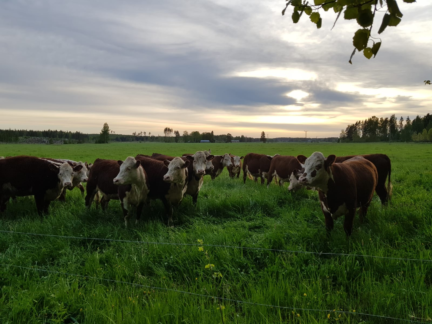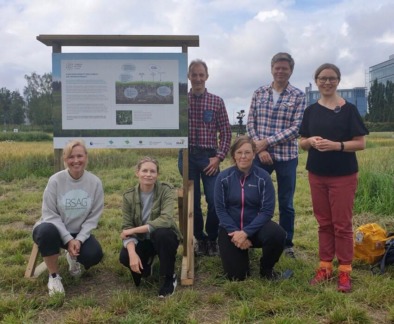Improving biodiversity impact assessment for regenerative farming
Regenerative Agriculture, Carbon Action
Measuring biodiversity with eDNA and assessing the biodiversity impact of regenerative agriculture
This research measures the biodiversity levels (in terms of species richness) of regenerative farms using environmental DNA (eDNA). Moreover, it utilizes these eDNA results to contribute to the improvement of life cycle biodiversity assessment methods specifically for regenerative farms.
Official name
Improving biodiversity impact assessment for regenerative farming using LCA and eDNA (ReDNA_LCA)
Duration
02/2024–01/2028
Persons in charge
Natasha Järviö, Johan Ekroos, Ville Uusitalo, and Hanna Tuomisto
Consortium
Lappeenranta-Lahti University of Technology LUT and University of Helsinki
Funder
Kone Foundation
Tackling biodiversity loss through agriculture
Biodiversity is vital for the health of our planet and our survival. Unfortunately, it is currently decreasing at an alarming rate. This loss is a challenge we should overcome, as we rely on nature for many essential ecosystem services, such as carbon storage, pollination, and purification of water. One of the main contributors to biodiversity loss is the agricultural sector. Activities such as land use, land-use changes, emission of greenhouse gases, and use of pesticides and herbicides all have significant impacts on biodiversity. If we want to increase biodiversity in farmlands, agricultural practices should change.
What is regenerative agriculture?
Regenerative agriculture is a farming method that has recently caught the attention of scientists, farmers, and industry leaders alike. Its core idea is to collaborate with nature, rather than against it, to develop a sustainable and productive farming system. Central to this approach is maintaining soil health. When soil is in good condition, it supports a range of essential ecosystem services that support both the farmer and nature itself. For example, taking care of soil boosts soil biodiversity, fostering beneficial microbes that recycle nutrients, facilitate plant communication, store carbon, improve water management, and protect plants from diseases naturally, reducing the need for chemical agents.
Developing biodiversity measures with environmental DNA
To know if our actions are successfully restoring farmland biodiversity, we need to track information and measure progress. Life Cycle Assessment (LCA) is a helpful tool, which uses models to estimate potential biodiversity loss throughout the whole studied activity. These models use characterization factors to translate the impact of activities, like the amount of land used for agriculture into the potential loss of species.
Characterization factors are based on available data and assumptions and so their accuracy depends on how closely the model reflects real-world conditions. Current data inputs are often based on conventional agricultural practices and therefore don’t represent alternative farming methods, such as regenerative farming. To update the model, more data is needed on the impact of agricultural practices on farmland biodiversity. For this purpose, we need more data on biodiversity levels from various types of land: conventional farmland, regenerative farmland, and natural areas.
Measuring biodiversity using environmental DNA
Traditional methods of monitoring biodiversity on land are often time-consuming, costly, and require expert knowledge. Additionally, they are challenged e.g. by weather events and juvenile life stages (which may be hard to recognize) and are prone to observational biases. This makes it challenging to accurately measure biodiversity levels and develop precise characterization factors for specific farming practices.
This project aims to use environmental DNA (eDNA) to measure farmland biodiversity accurately and effectively across several regenerative farms. The results of the eDNA analysis can be used to improve the life cycle biodiversity impact assessment methods to better assess the impact of agricultural decisions on biodiversity. This allows other regenerative farmers, policy makers and LCA practitioners to assess and include the biodiversity impacts of regenerative farming within LCA in a more accurate way in the future. This also means that the potential benefits of regenerative farming are more accurately captured.
Collecting eDNA samples
All living organisms leave traces of DNA through activities like shedding cells, excreting waste, moulting, and reproduction. By using eDNA technology, scientists can collect this genetic material from the environment, such as from soil, water, faeces, or even air, and identify the organisms that are or have been present. Collecting eDNA samples requires less resources and expertise than traditional monitoring method and samples are more likely to detect rare or elusive species better.
In this project, eDNA samples are collected from various landscapes across the South of Finland. Different land types are studied to understand their biodiversity: both croplands and pasturelands, including regenerative farms, conventional agriculture, as well as traditional rural biotopes as a natural reference point. These samples will help to develop new characterization factors for LCA. Finally, the aim is to conduct a case study to test these factors and evaluate the biodiversity impact of regenerative farming.
Contact
Natasha Järviö, LUT / University of Helsinki, natasha.jarvio@lut.fi
Project Phases
03/2024 – 08/2025
Phase I
eDNA sampling
Designing a sampling strategy by partnering with farms practicing regenerative and/or conventional agriculture. Collecting and analysing eDNA samples during August of 2024. The samples will be sent to a laboratory where they are analysed, and the presence of various taxa are identified.
04/2025 – 03/2026
Phase II
Characterization factors tailoring
Using the eDNA results, new characterization factors will be created for assessing life cycle biodiversity impact methods. These factors will be created using available scientific equations with the gathered eDNA data on species richness. The possibility to include also other biodiversity indicators (such as the abundance of species) will be investigated.
03/2026 – 09/2027
Phase III
LCA of regenerative farming
Conducting an LCA on a real farm practicing regenerative agriculture in Finland. Collecting real farm data, and applying the improved characterization factors to test the accuracy of the improved method.
PROJECT PARTNERS




